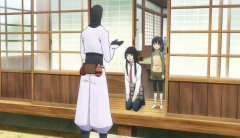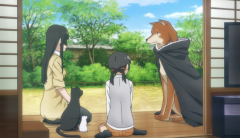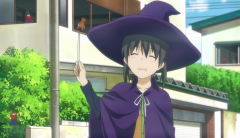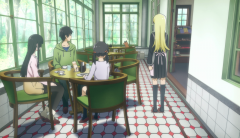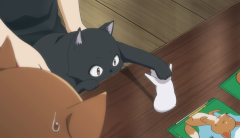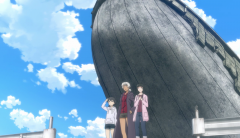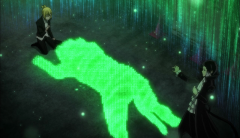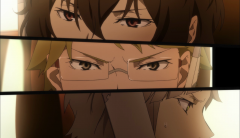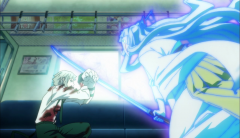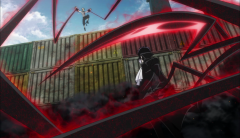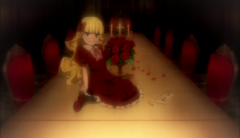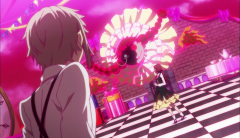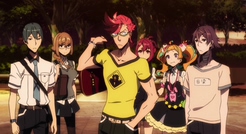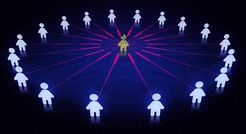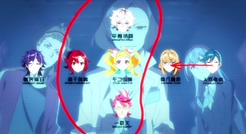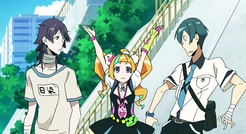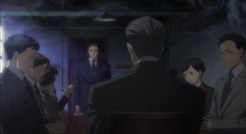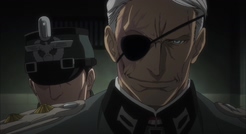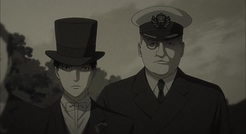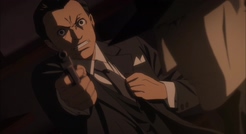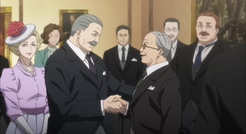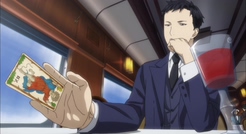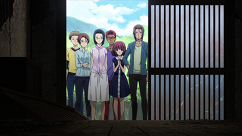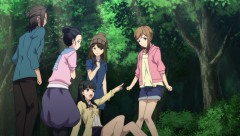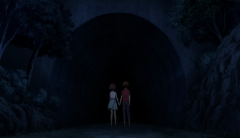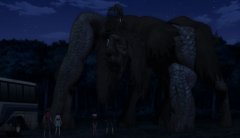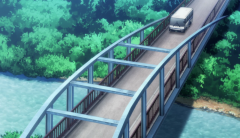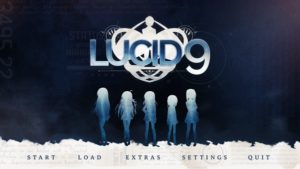As I mentioned in one of my weekly posts, most of the reason why a slice-of-life anime show don’t work well is not because there’s nothing happen, but more because the cast isn’t interesting enough or the show tends to repeat the things that we already know. I’m happy to say that this is not the case for Flying witch. Flying witch has all the elements good slice-of-life shows have and moreover it presents itself as one of the finest in the genre in years. The slow and deliberate pacing and the strong sense of atmosphere maybe the whole reason why people keep coming back to watch it.
Story-wise, the show focuses on two main themes: the first theme is how Makoto the witch learns and lives her rural country lives. There are segments that as mundane as possible: Makoto learns to plant, the cast cooks hamburger, they go for herb-picking or thinning the apple trees. But the details they put in both show how they really care about the process, and help maintaining the relaxing atmosphere till the end. In Flying witch world, time will pass and people may get old, but growing plant, eating hot cakes and wandering around might be the best ways to spend your day. The second theme is to produce a mix of magical realism in this everyday life. By introducing new characters: The Harbinger, another witch, the witchcraft, the witch café or at the end the flying whale and Earthfish, the show showcases a sense of wonder, a touch of magic that feels almost like, well, actual magic. It helps that the introduced characters are endearing and have a very easy chemistry, they are both display on how each of us is different and have different purpose from each other, but ultimately we are all part of mother nature.
Aside from the atmosphere, the cast is easily one of the highlights of the show. Rarely in anime that I see a cast who feel really natural and thus, true to life like our friends around us. Chinatsu, for example, acts exactly like how 12-year-old girl would act. Her ever curiosity, her excited over whenever she encounters new things, are so natural and exactly herself. Chito the cat acts like any normal cat would, and then some. Indeed, one of the greatest strength of the show is how everyone in the cast are so consistent, yet each episode we could learn something new about them. Like we only learn that Nao is so clueless in kitchen on the last half of the show, or until the second encounter that we learn Anzu is really knowledgeable about history. Each of the cast also fits in the shows perfectly and it has been so long that I found myself enjoying so many characters like this one. Moreover, the chemistry between the cast is what makes this show shines so much. I always enjoy little moments shared between some of their cast: like back-and-forth conversations between Chinatsu and Inukai, or Nao and Chito the cat, or Anzu and Kenny the white cat. The chemistry between the siblings: from Kei and Chinatsu, to Makoto and Akame is also well-spot, they’re siblings and their personalities are so different, but they understand each other and I can feel the warm feeling they have for each other. All these little moments help build up the chemistry and make the show so rewarding to watch over and over again.
But the show not only shine for its laid back atmosphere, Flying witch is also known for its understated details. It furthers showcase how the staffs put so much effort to this show so that it feels almost effortless. Those little details that we can easily miss the first time we watched, like Makoto put her broom in “vehicle parking” section in one episode, or how the hamster shakes himself uncontrollably every time he finds himself near Chito the cat. Those details could indeed be very rewarding on repeated viewing. While the show is much more an atmospheric spectrum than comedy side, this show also has very solid understated comedy and always has a very good sense of putting a final punch. The quick remark from Chinatsu about her Mom for example “I heard that old people aren’t easily surprised” is both very whimsical and modest. The punch where Akame giving Chinatsu and Makoto her presents had to be one of my favorite part of the show.
Indeed, because of its relax tempo and slow pacing, it is destined for a lazy Sunday afternoon watch (which was exactly the time it’s available here in Australia), that’s feel true as in many of the episodes -for some characters – all they do is taking a nap. Ultimately, Flying witch is a celebration of the joy of everyday life, with a little touch of magic to create a sense of wonder that life and nature could bring to us.
~SuperMario~

